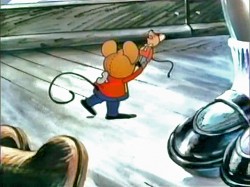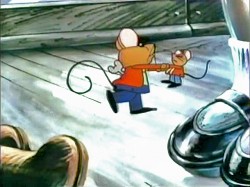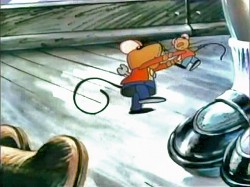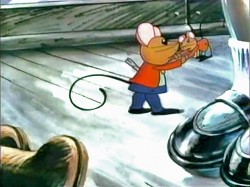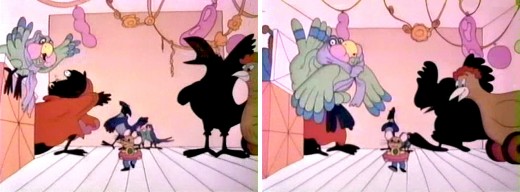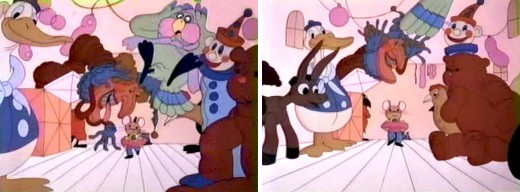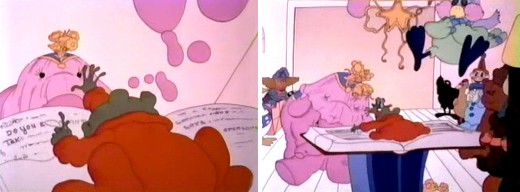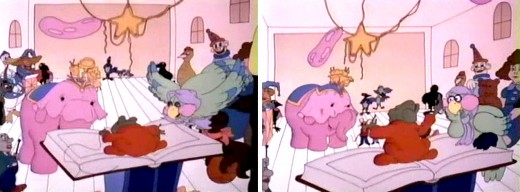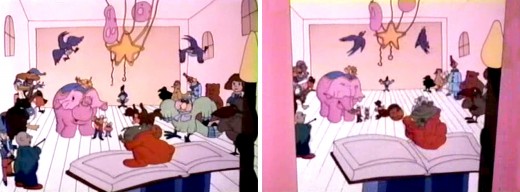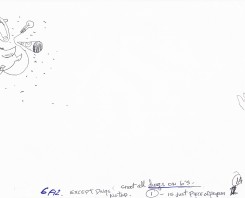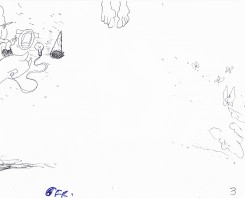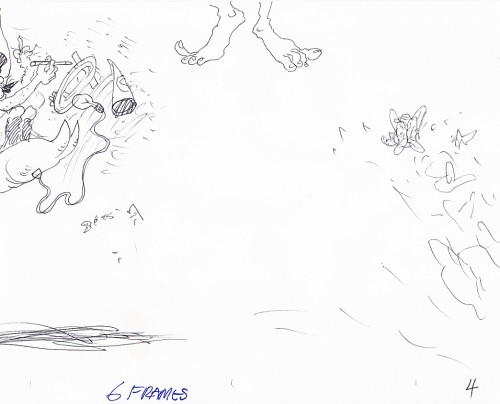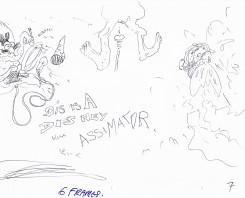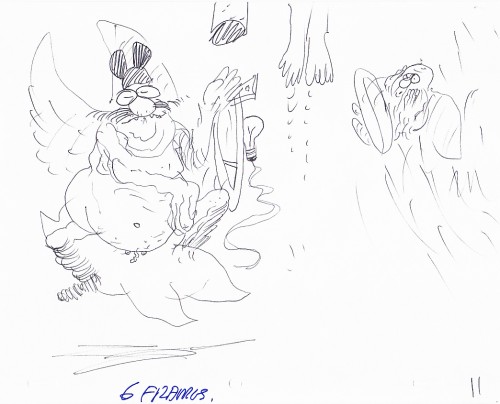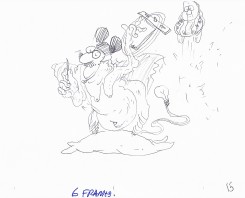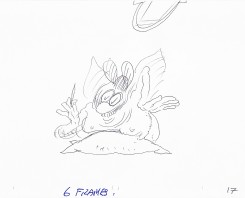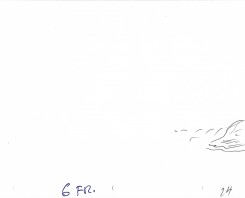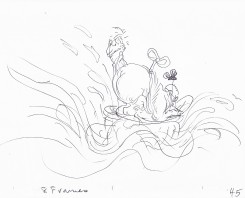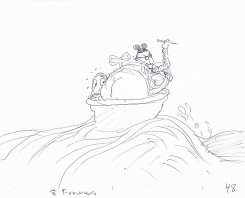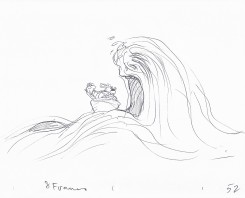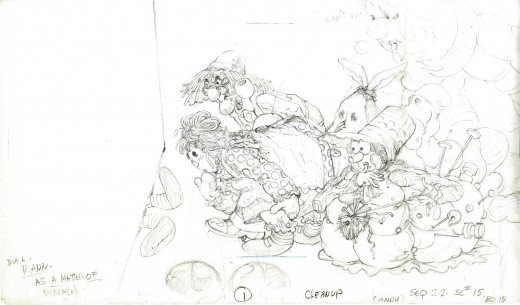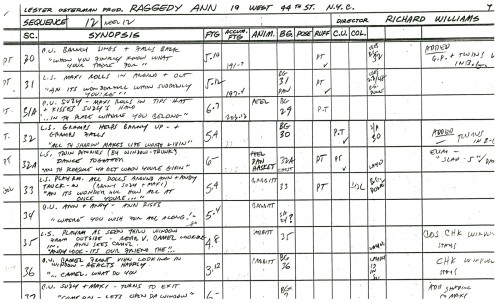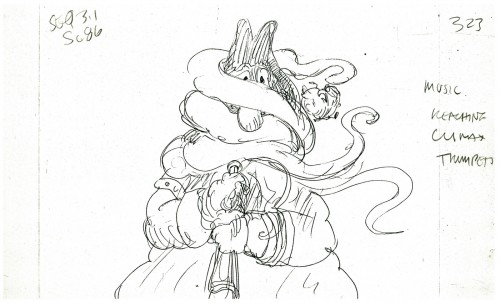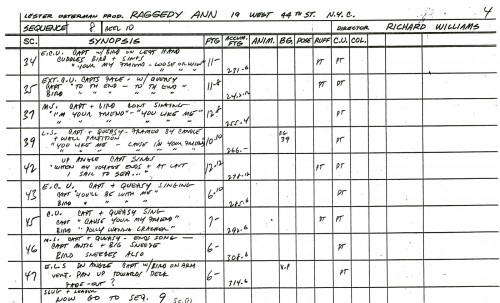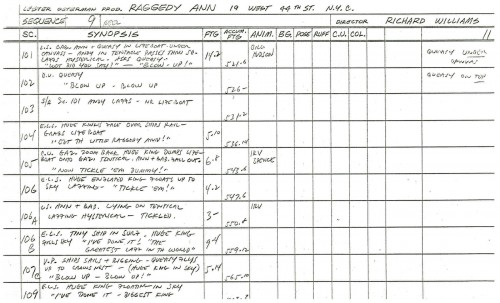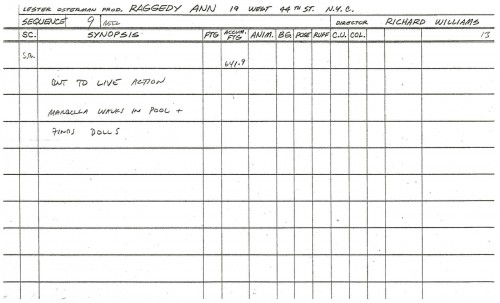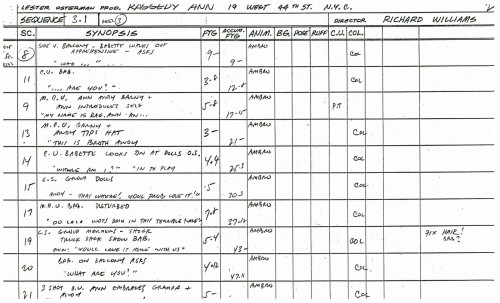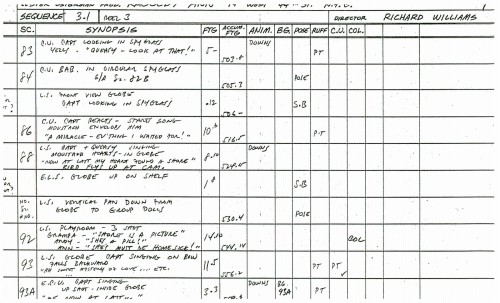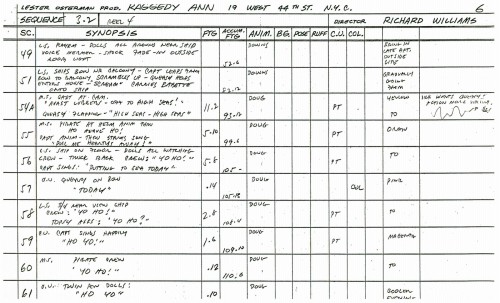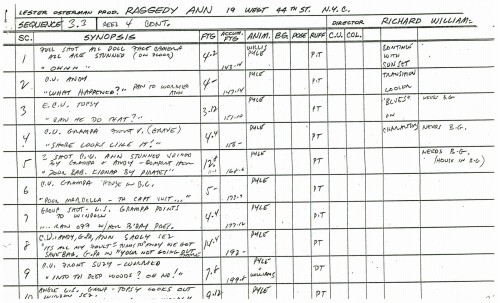Search ResultsFor "corny cole raggedy ann"
Daily post 12 May 2013 07:19 am
Even More Raggedy Photos – 3
We haven’t quite finished with the collection of photos John Canemaker loaned me; these were the images he took for his Raggedy Ann book. Not all were chosen, but all were snapped by John.
I’ve chosed to post the photos and use them as a way for me to reminisce on the subject at hand. Lots of looking back, memories and other photos in my mind.
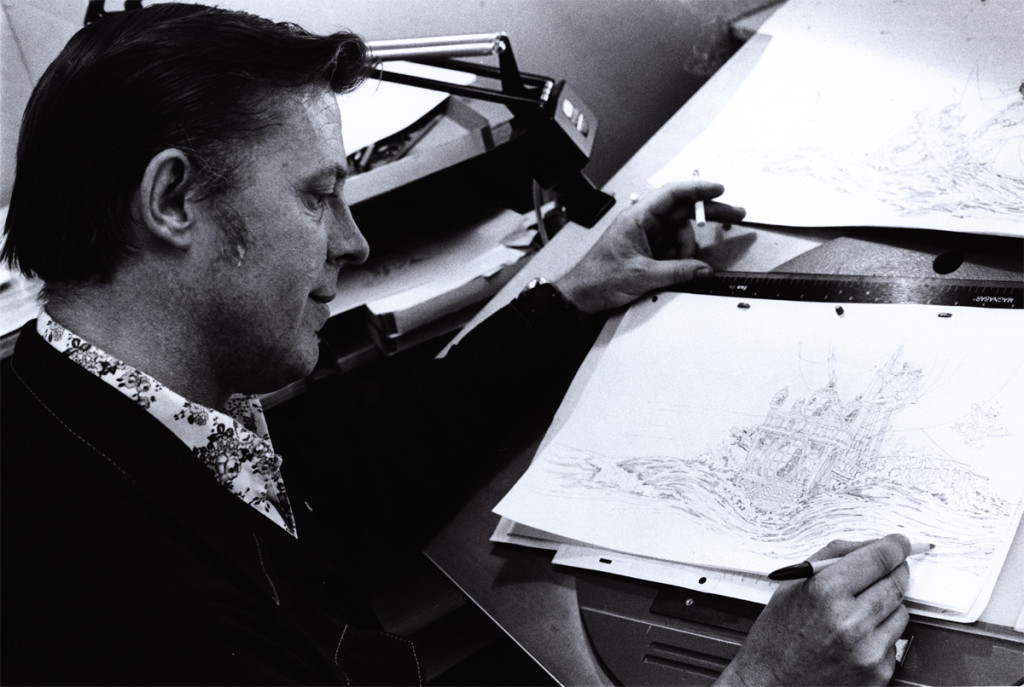 1
1Here we have animator, Doug Crane. Doug has always specialized
in the details animated. Animated roads, moving crowds or
animated news papers. doug has animated these all as his forte.
In Raggedy Ann, Doug was to do much the same as those scenes that
were animated by Corny Cole. Lots of moving sea, ships and cross
hatching. His scenes all have the necessary dynamic of a vast sea
of lines.
 2
2
Harry Chang was a number 1 editor of animation in NYC prior to
his being hired by Dick WIlliams for this job. Harry maintained
his status, though they did pull an older editor out of retirement
to do the track readings. Max Seligsman was so
brilliant at the track reading that I still haven’t found anyone who
did the job as meticulously as he. His music readings broke all the
sounds of the orchestra down to color-coded frames. Unfortunately,
there were no photos of Max in this collection.
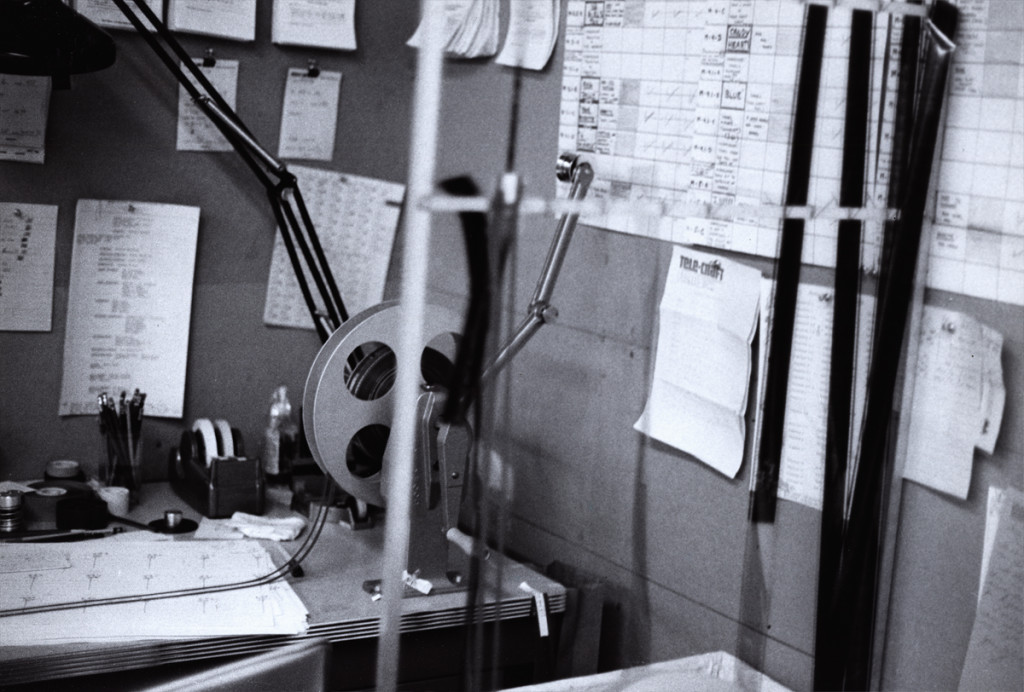 3
3
This is the editing table of the NY editor, and the film’s
lead editor, Harry Chang. He was very particular
and kept a very neat editing room. I often spent hours working
with him and Dick as we analyzed what was wrong with some of the
early animation scenes.
 4
4
This is Lee Kent. She was the West Coast’s animation editor.
She came to New York toward the end of the production when
it was decided to house the East & West Coast Units under the
one roof. Lee had to work with Harry to get everything in sync
and in place for the ever-growing movie.
 5
5
Paulette(assistant animator) and Charlie Downs (animator).
I looked forward to meeting Charlie. When Ward Kimball had
to pull a number of assistants up to being animators for
the Disneyland TV shows he had to rush out for Disney,
Charlie Downs was among that group. He made the rise just
slightly faster than he might have. There’s no doubt he was
ready for the promotion.
 6
6
A photo from the West Coast’s group of people:
Animators Art Vitello (foreground) and John Bruno (middle),
and assistant animator, Paulette Downs (in rear).
 7
7
Animator, Crystal Russell rose quickly on Raggedy Ann. Her animation
style beautifully blended with Tissa’s animation of Ann & Andy.
Crystal became important for picking up many of the scenes that Tissa
couldn’t get to. She did many rich, ad strong scenes bringing a
lyricism to the work. Dick brought her to London on completion of
Raggedy Ann & Andy. She worked there for about six months before
heading back to LA where she did some great work on Lord of the Rings.
 8
8
Ida Greenburg (right) and Nancy Lane (left).
Ida was the head of Ink and paint on the film. There were about
150 people working for her. Nancy Lane was Ida’s 2nd in command.
I had worked closely with Ida at the Hubley studio on a few
projects. I really liked her enormously and enjoyed going down
to the I&Pt det to help clarify some problems their checkers would
find. I’d spend about an hour or two there each day depending on
complications they’d locate.
 10
10
Nancy Lane. I’d been there when Nancy got her first promotion
to supervising a project. She was a real go getter who absolutely
took charge of anything job she was given.
 11
11
A wall of cels from Art Babbitt‘s sequence.
The Camel with the Wrinkled Knees. He also had bad feet.
 12
12
Art Babbitt with Dick Williams.
I always felt that they’d had similar animation styles. They
took different paths getting there, but the work was not too different.
That’s production manager, Carl Bell, on the phone.
 13
13
The storyboard. Andy has a problem in the taffy pit.
That was Emery Hawkins’ sequence. He only made one
short trip to NY, and I didn’t get to meet him. We
did speak on the phone a couple of times.
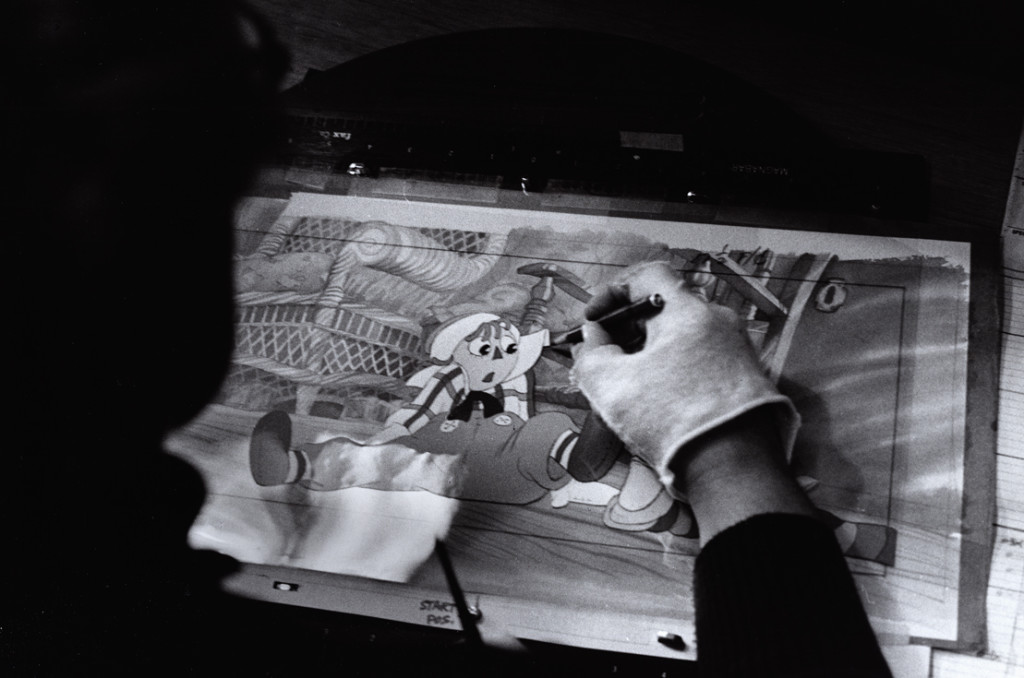 14
14
Andy lands on the floor to end a musical number. The days
when cels were painted. Here, an inker is doing touch up
work on the Xerox line. She’s using a “lumograph” pencil.
These pencils were able to draw on cel. Dick would animate
on cel with these pencils. This is what he used to animate
the Jovan commercial.
 15
15
Here a checker makes a small touch-up on a cel.
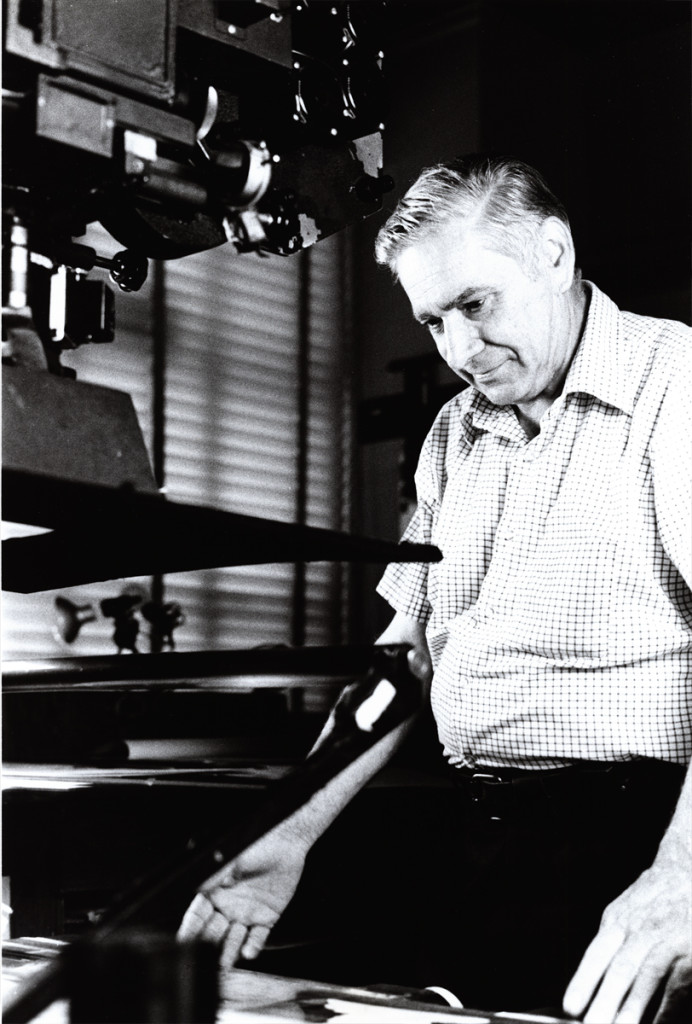 16
16
Here camera supervisor, Al Rezek, is shooting a scene
on the Oxberry camera.
 17
17
The camera was tricked out with a Panavision lens which was
rented from Panavision. At first there were a lot of problems
with the Cinemascope format, and a lot of tests were done for
the larger screen. However, when I saw it at a local theater.
They reduced the image and cut off the top and bottom.
Ultimately, the screen size was smaller – not larger.
 18
18
This is Jim Petries. He was this sound effects guy who
specialized in animation. He’d show up and would foley
the entire film on the spot in the mix studio. The film
makers got to watch quite a show a he pulled it off.
 19
19
I believe Jim also did some work on Everybody Rides the
Carousel for John & Faith Hubley.
 20
20
This shows two young inbetweeners that rose within the industry.
Mary Szilagyi is drawing at the desk, and Carol Millican is in
the foreground. Mary stayed in NY ultimately doing children’s books
and Carol went to the West Coast working for many studios.
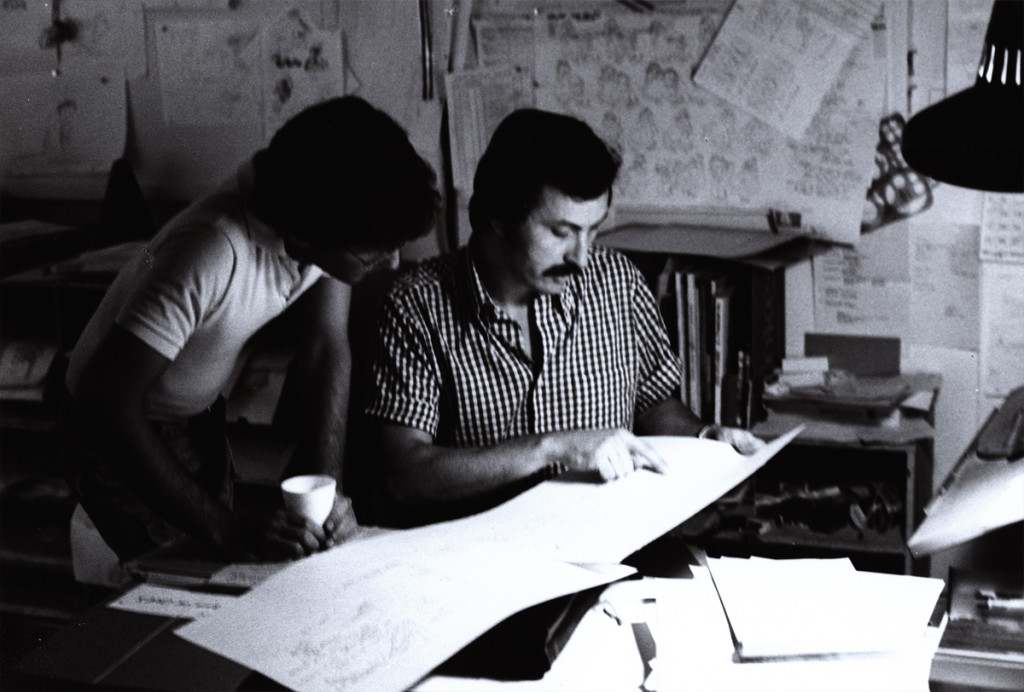 21
21
The Asst Director, Fred Berner, looks over the shoulder of
Associate Director, Cosmo Anzilotti. Fred left animation
and produced a number of excellent theatrical features before becoming the
lead producer on Law & Order: Criminal Intent. Cosmo went
out to the West Coast to take a lead position at Hanna Barbera before they
closed their doors. He helped during the transition period as the turned into
Turner Animation Studio. He retired notlong after.
They were both good friends. I still run into Fred every once in a while,
usually at Academy meetings.
Books &Commentary &John Canemaker &Photos 28 Apr 2013 05:55 am
Raggedy Ann Photos
- John Canemaker recently loaned me a stash of photos of the Raggedy Ann crew. These were pictures that were used in his book on the “making of”. It was a better book than movie (as they often are). There are also some photos that didn’t make it to the book. John Canemaker shot all the photos, himself and all copyright belongs to him.
I thought I’d post the pictures and add some comments that pop off the top of my head. Hopefully, a couple of interesting stories will show up in my memories.
There are enough photos that it’ll probably take about three posts to get them all in. The next two Sundays are booked, I’d guess.
 1
1Johnny Gruelle (artist, writer) and William H. Woodin (song writer)
Dec.28, 1930 Indianapolis Star – “Raggedy Ann’s Sunny Songs”
This was apparently a theatrical piece Johnny Gruelle
put together with his very successful characters.
 2
2
It all started with Joe Raposo, the composer of “Bein’ Green”
and many other hit Sesame Street songs. He wrote a musical for “Raggedy Ann
and Andy” and was made to see that it would make a wonderful animated musical.
 3
3
He wrote a lot of songs for the slim script and they prerecorded
the songs for the animation. We lived with a soundtrack of about
a dozen musicians playing this very nice score to the delicate voices
that sang the tuneful pieces.
 4
4
We heard this at least once a week as the animatic/story reel
grew into a full animated feature shot completely in Cinemascope.
 5
5
When the final film was released, that 12 person orchestra
became 101 strings and a big over-polished sound track.
No matter where you went the music was there and in the way.
It was too big, and the movie was too small. It was bad.
The track was incredibly amateurish. The composer had too much control.
 6
6
This was Richard Horner. He was one of the two producers of the film.
Stanley Sills (a Broadway producer and Beverly’s brother) was the
other producer who didn’t know what he was doing.
They represented Bobbs-Merrill who owned the property.
I really liked Mr. Horner. We met again a number of years later
when Raggedy Ann was distantly behind us. I’d offered to take Tissa to church,
one Easter Sunday; Richard Horner and wife were there. He asked to meet with me.
He sought advice on some videos of artists and their work that he was producing,
and hoped I could offer my help in leading him to some distributors.
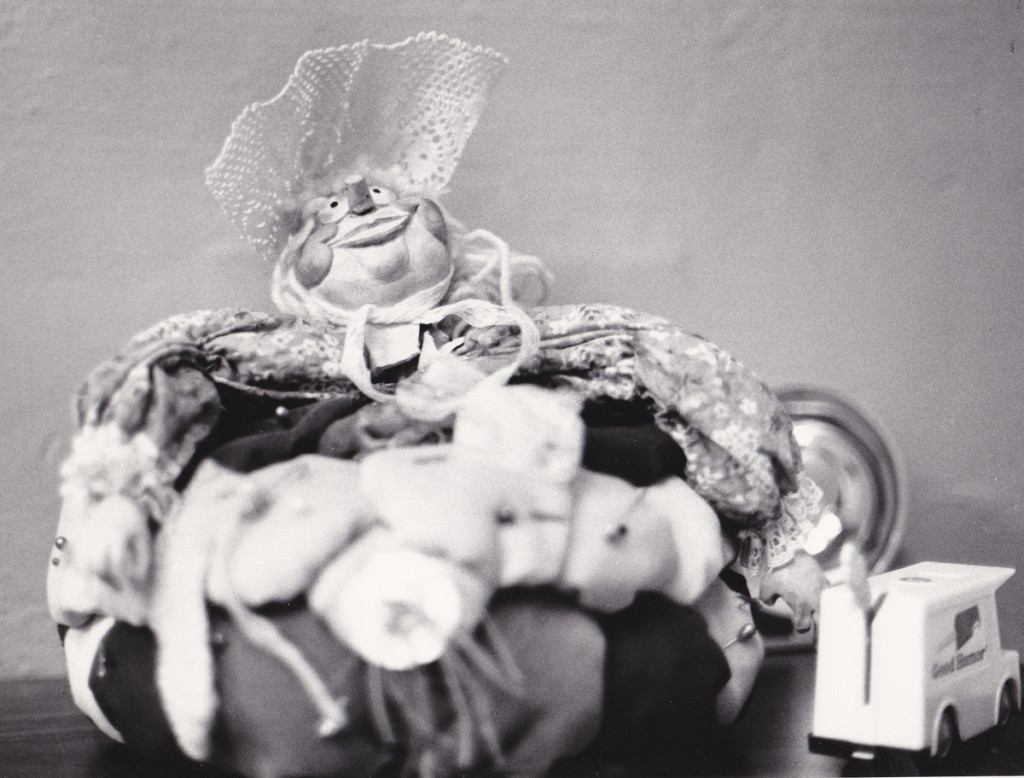 7
7
This is one of the dolls in the play room,
Susie Pincushion. She was charming.
 8
8
This is Cosmo Pepe; he was one of the leaders of the Xerox department.
It was Bill Kulhanek‘s department, but Cosmo really did great work.
They had this room-sized machine that they converted drawings into cels.
It was all new to NY, and the whole thing was so experimental.
Especially when Dick decided to do the film with grey toner rather than black.
The film always felt out of focus to me (even though it wasn’t.)
In the end when they rushed out the last half of the film, Hanna Barbera
sub-contracted the Xeroxing, and it was done in a sloppy and poor black line.
 9
9
This is Corny Cole. He was the designer of the film, and all the great art
emanated out of his Mont Blanc pen nib. Or maybe it was a BIC pen.
Whatever, it was inspirational.
I wrote more about him here.
 10
10
The gifted and brilliant animator, Hal Ambro. Can you tell that
I admired the man? I wanted badly to meet him during this production,
but that never was to happen. Now, I can only treasure his work.
 11
11
This is a very rough planning drawing that Grim Natwick did on
the Jack-in-the-Box he animated. See the scene here.
 12
12
Here’s a close up of that very same drawing.
 13
13
Mark Baker did the voice of Raggedy Andy.
He’d won the Tony Award as Best Featured Actor in the musical, Candide.
 14
14
Didi Conn, the voice of Raggedy Ann, with Chrystal Russell, an animator
of Raggedy Ann. She backed up Tissa David who was the primary actor for
that character and did most of the film’s first half. Chrystal did many
scenes in the first half and most of the second.
She had a rich identifiable style all her own.
 15
15
Sue Butterworth, head of the BG dept who designed the watercolor style
of the film. Michel Guerin, her assistant, can be seen in the rear.
Bill Frake was the third part of that BG department.
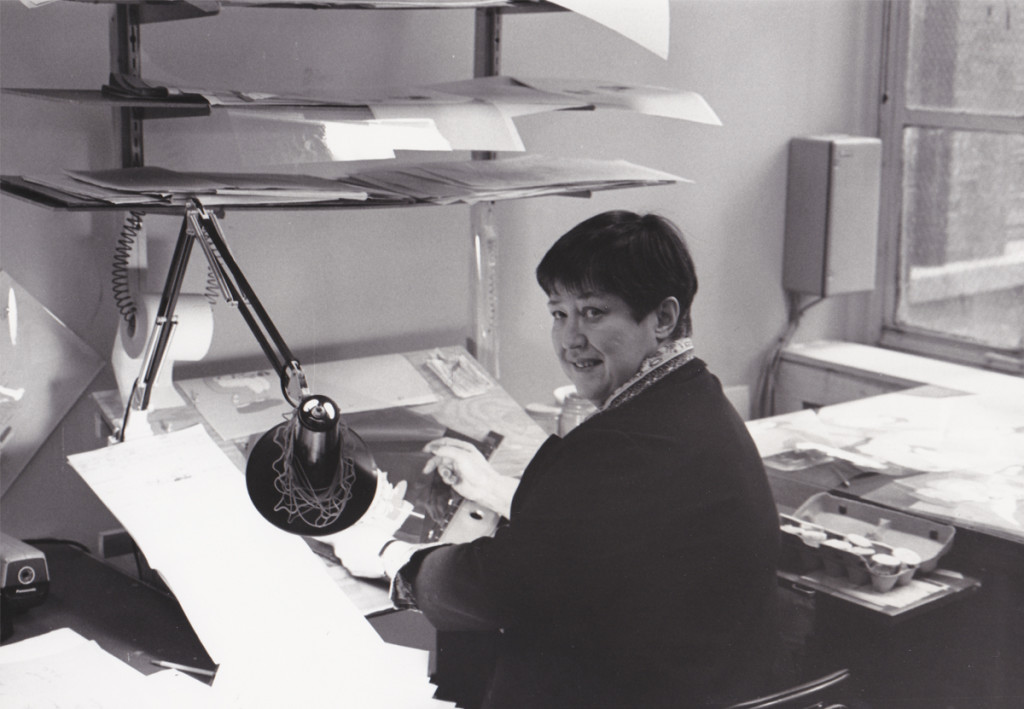 16
16
Painter, Nancy Massie. A strong and reg’lar person
in the NY animation industry. She’d been working forever for a reason.
On the average, I spent about an hour a day down in the Ink & Pt dept.
Often they had problems to resolve with some animator’s work. Either the
exposure sheets were confusing or they didn’t match the artwork, or there
was some question that they found confusing. My being available made it
helpful to them, and I did so without hesitation.
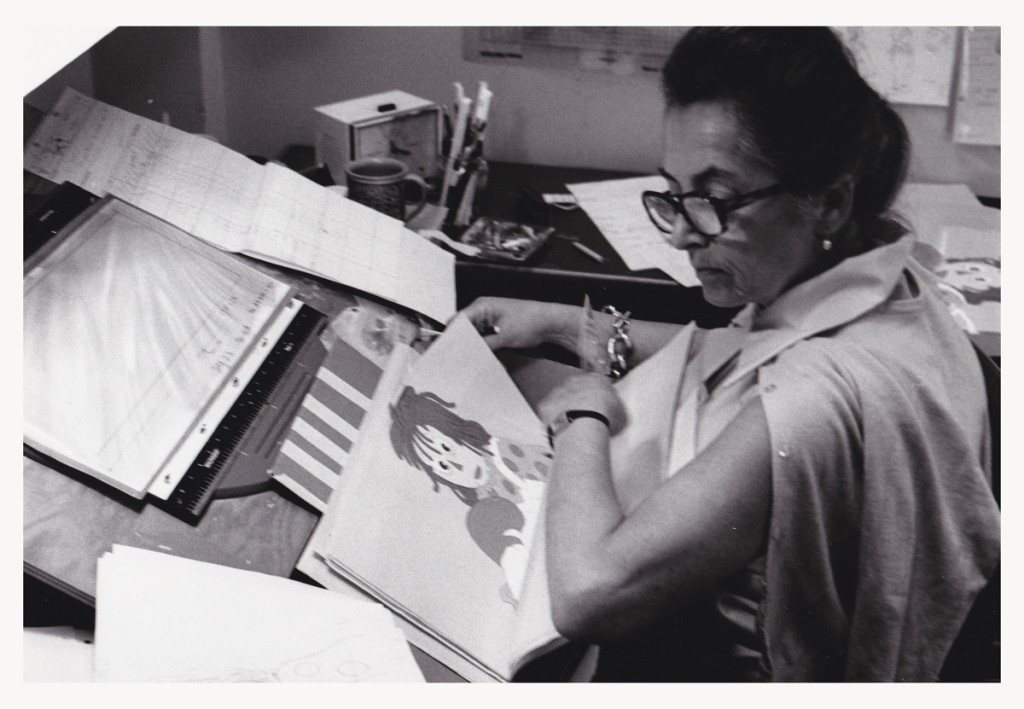 17
17
Checker, Klara Heder. Another solid person
within the NY industry.
Generally, before a scene left my department for the I&Pt dept., I’d
have studied the exposure sheets and felt I knew the scenes before
they were handed out to the Inbetweener or Assistant. It meant taking
a lot of time with the work in studio so that I was not only prepared
to answer questions of a checker but the Inbetweener as well.
 18
18
Sorry I don’t know who this is. If you have info,
please leave it for me. For some reason, I’d thought
he was an inbetweener (which would’ve made it odd for
me not to recognize him by name.) Apparently he’s a painter.
 19
19
Carl Bell was the West Coast Production Coordinator.
We spoke frequently during the making of the show.
When I left the film, I went to LA for a couple of weeks.
Chrystal Russell threw a small party for me, and Carl came.
(I think he might have brought Art Babbitt, who was there.)
The group was small enough that we could have a talk that we all
participated in. We talked for some time (though not about
Raggedy Ann.) It was great for me.
 20
20
Jan Bell, Carl’s wife, was the West Coast Office Manager.
 21
21
Maxie Fix-it. This was a great doll that wound up to get the legs going.
He rolled around the floor beautifully. The “Twins” in the back were animated
by Dan Haskett. though I’m not sure they gave him credit for it. I was a bit
embarrassed by these characters. They were just a naked bit of racism running
about our cartoon movie for very young children.
 22
22
Gerry Potterton (left) and John Kimball (right).
Gerry was one wonderful person. I always enjoyed spending time with him.
He produced/directed a number of intelligent, adult animated films.
This includes an animated Harold Pinter‘s Pinter People.
After Raggedy, I tracked Gerry down to get to see Pinter’s People. It was
rather limited but full of character. Gerry knew how to handle the money
he was given, unlike some other directors.
John Kimball was, at the time, not in the caliber of Babbitt or Ambro or
David or Hawkins or Chiniquy. However, he did some imaginative play
on a few scenes which were lifted whole from strong>McCay’s Little Nemo
in Slumberland. One of these scenes I animated but was pulled
from it before I could finish it. I had too much else to do with the
tardy inbetweens of Raggedy Ann (an average of 12 drawings per day)
and the stasis of the taffy pit (an average of 1 inbetween per day).
Too many polka dots on Ann and too much of everything in the pit.
 23
23
Fred Stuthman, the voice of the camel with the wrinkled knees.
He did add a great voice for the camel, though for some reason
I remember his being a dancer, predominantly.
All photos copyright ©1977 John Canemaker
.
Articles on Animation &Richard Williams &Tissa David 01 Oct 2012 06:37 am
Raggedy Ann and Andy
- On Tuesday, October 23rd a memorial service for Tissa David will be held at the Lighthouse Academy Theater at 111 East 59th Street. It will begin punctually at 7pm. Seats will be available on a first-come first-served basis. To continue celebration of Tissa’s work, here’s an article that appeared in Cartoonist Profiles Magazine, No.33, March 1977. No writer’s name is credited.
We thank Mike Hutner. of Twentieth Century-Fox, for the production notes about this new full-length animated film, RAGGEDY ANN & ANDY, which is having its world-premiere in New York on March 20th.
 Raggedy Ann is a caricature of a rag doll, with stringy red hair, button eyes and a painted triangular nose.
Raggedy Ann is a caricature of a rag doll, with stringy red hair, button eyes and a painted triangular nose.
Harold Geneen is the Chairman of the Board of the ITT Corporation, an industrial empire which includes hotel chains, construction companies, the Bobbs-Mcrrill book publishing house and a car rental lirm which tries harder.
It was hardly destined that they would be linked in one of the year’s most ambitious entertainment ventures. But the proof is on 35mm Panavision film, in the form of “Raggedy Ann and Andy,” the feature-length animated musical from 20th Century Fox.
The genesis of the full-length am mated musical—one of the few such projects attempted during the past few decades without the Disney insignia—is a story which has its own touches of fantasy. In addition to ITT’s Board Chairman, the principals include:
• A team of Broadway theatre-owners and producers, who never before made a movie, lei alone an animated feature.
• An Emmy-winning composer, one of whose songs was a hit for both “Kermit the Frog” and Frank Sinatra.
• An Academy Award winning director who thought he was out of the picture until he look part in an all-night jam session at his Soho studio.
• Several legendary cartoonists, including the originator of “Betty Boop” and the man who gave Disney—and the rest of America—the beloved “Goofy.”
How they came to join forces really begins in Silvermine, Conn, in the early 1900′s. when newspaper cartoonist John Gruelle took a few minutes away from his drawing board to help his daughter fix a discarded rag doll. The toy was named “Raggedy Ann” by combining characters from two poems by James Whitcomb Riley — The Rag Man and Orphan Annie.
When Marcella Gruelle became desperately ill, her father sat by her bedside, making up stories about the doll’s adventures after everyone in the house was asleep. Marcella died on March 21st, 1916. after which her father determined to share with the world the stories he had not had time to tell her.
By the early 1970′s. Raggedy Ann was part of American folklore, a character whose exploits had sold some 80 million books and hundreds of millions of toys and games. That was when Lester Osterman. a former stockbroker who brought Sammy Davis Jr. to Broadway in “Mr. Wonderful.” and Richard Horner an ex-actor who had appeared in the Oberammergau “Passion Play” became involved. The producers of such Broadway successes as “Butley” and “Hadrian the Seventh,” they had just completed a live-action television special for the Hallmark Hall of Fame, based on the children’s classic. “The Littlest Angel.” Now they were searching for a similar property . . . for the same showcase.
A casual lunch with a merchandiser of children’s toys proved crucial. “Would you believe that after all these years. ‘Raggedy Ann’ is -.till one of the biggest sellers?” inquired the friend rhetorically. Within a few days. Osterman and Horner were on the doorstep of the Bobbs-Merrill Company, which publishes the “Raggedy Ann” stories, requesting development rights to the character.
An equally informal meeting with Joe Raposo. Emmy-winning composer-conductor of “Sesame Street,” brought music to the project. Horner and Osterman found themselves seated with Raposo at a Friars’ Roast for Johnny Carson. Somewhere between the broiled chicken and dessert, Raposo agreed lo score the “Raggedy Ann” tales.

Animators Tissa David and Art Babbitt with director Dick Williams.
Next to join the troupe were writers Max Wilk and Pat Thackeray. True to Gruelle’s imagination, they created a fantasy world in which toys spring joyously to life. When Raggedy Ann discovers that the pixieish French doll, Babette, has been kidnapped by a pirate known as Captain Contagious, they set out to free her. That takes them into the “deep dark woods”, inhabited by such personalities as the “Looney King,” “the camel with the wrinkled knees” (one of Gruelle’s personal favorites) and the “Greedy,” a kind of confectionery version of the La Brea Tarpits. “We thought we were writing a live television special,” recalls Ms. Thackeray. “So much so that we began casting Raggedy Ann in our minds, alternating between personalities like Liza Minnelli and Goldie Hawn.”
But Raposo was having second thoughts. “It won’t work,” he finally admiitted. “Put a red fright wig and a painted mouth on an actress— any actress—and do you know what you’ll have? A circus clown.”
The obvious alternative was a full-length animated musical cartoon. Which is like saying the obvious alternative to your reliable family car is to go out and buy a Rolls Royce. There is a reason, as director Richard Williams would later point out, why animated features are almost exclusively the province of the Disney organization. “And even Disney turns out several live comedies and nature films for every animated movie.” Williams notes.
To create 90 minutes or more of full animation (as opposed to the jittery short-cuts of television cartooning) requires more than one million preliminary and final drawings. From inception to “answer print” lakes three years or more. “And the cost,” adds Williams, “is tremendous.”
“Since the Hallmark people had discussed a live musical, they were perfectly justified in walking away from a more costly animated feature,” says Horner. The producers now had a cartoon without a cartoonist, a television special without a sponsor, and a project without investors. But it was no time to think small. Why settle for a television special? Why not make “Raggedy Ann and Andy” as a movie?
It was back to Bobbs-Merrill with the suggestion that Osierman-Horner and the publishing house become partners in the proposed film. That, the publishing executives said, was up to their parent company, ITT. A meeting was arranged with Board Chairman Geneen. which developed into a corporate backers audition.
Pat Thackeray later described the “incredible afternoon” to author and critic John Canemaker, whose book, “The Animated ‘Raggedy Ann and Andy’-The Story Behind Ihe Movie,” will be published at the same time as the 20th Century Fox release.
“Geneen came into the room, asking questions, his mind like a laser,” she said. “He remembered a stage version of ‘Raggedy Ann’ he’d enjoyed as a youngster, in the I920′s. We made our presentation. Then, as we were going down in the elevator, a guard told me, ‘I don’t know who you are but you’ve got it made.’
“I asked why.
“The guard said, ‘Because the old man stuck his head out of the door and asked what I thought of the music coming from his office. I said it sounded pretty good to me. That wasn’t just good, Harry,’ he said, ‘that was terrific.’”
With financial backing assured, the next problem was simple. Who would draw the million-plus pictures which would make up the finished movie? And who would piece them all together with wit and style?
Firsl choice was Richard Williams, the Canadian-born, London based head of his own animation studio who had won an Academy Award for “A Christmas Carol” and a host of admirers for the “Return of the Pink Panther.” Despite a commitment to his own project, “The Thief and the Cobbler” Williams listened to Raposo’s score, and said yes.
“But my business manager said ‘no,’” Williams recalled. “Or to put it more accurately. he priced my services so high, there was no way the picture could have come in on budget.” What happened to the business manager? “He’s not with me anymore,” Williams replied with British sang-froid.

Tissa David’s rag doll
Osterman and Horner began negotiations with a New York cartoon “factory” which specialized in limited animation for television. Within a short period (according to Canemaker), the newcomers had virtually thrown away the Wilk-Thackeray script, replacing Gruelle’s characters with a “Love Fairy” and a “Cookie Giant.” Outraged. Raposo walked out of a story conference (“before 1 threw up from all that treacle,” he recalls) and caught a plane to London to make a last-ditch attempt at hiring Williams.
Discovering a shared taste in jazz, the two men opened a bottle of Scotch and during an impromptu jam session, past misunderstandings vanished in a vapor of 12-year-old malt and good will. The animated movie finally had an animator.
It was Williams who formulated the approach to the picture. “Disney’s contribution to animation is colossal,” he said. “The technique of bringing a cartoon character to life would slill be in the dark ages without Disnev. But to copy the ‘look’ of his films would have been disastrous.
“Instead, 1 said, ‘let’s be as rich and lush as Disney in a totally different style … in the style of Johnny Gruelle.’”
A remarkable team of animators was assembled in New York and Hollywood lo carry out that mission. Included were several men and women who can legitimately be termed ‘living legends’ in the field of motion picture cartooning.
There was Grim Natwick, a spry octogenarian, who had designed the first of the “Betty Boop” pictures for producer Max Fleischer in the thirties and animated the majority of Snow White’s scenes for Disney. Another Disney veteran was Art Babbitt, the co-creator of “Goofy” and the dancing mushrooms in “Fantasia,” whose verbal donnybrooks with Disney during the I940′s had been peppery Hollywood gossip.

85 year old animator Grim Natwick
with young animator Crystal Russell
To draw the “Greedy,” a ‘monster’ made of whipped cream, cherry banana taffy, chocolate fudge and other sugary delights. Emory Hawkins—a veteran of Disney as well as the MOM and Warner Brothers cartoon studios -was summoned from his New Mexico ranch. “Raggedy Ann” herself was drawn by Tissa David, a Transylvanian-born artist who had worked with Natwick at UPA Productions during the heyday of “Mr. Magoo” and “Gerald McBoing Boing.”
From Canada came Gerald Potterton, head of his own animation studio. whose credits include the Peabody Award winning “Pinter People” and key sequences in the Beatles’ “Yellow Submarine.” The design of the vital storyboards and layouts which gave the picture its graphics stamp was up to Cornelius “Corny” Cole, both an animator and a renowned painter.
The musical routines for the “Twin Penny Dolls,” whose movements are perfectly synchronized with each other, were drawn by Gerry Chiniquy. who looks like Gene Kelly and specializes in “dance animation.” During a ten year period at the Warner Brothers Studios, whenever Bugs Bunny or Daffy Duck were called on to trip the light fantastic, Chiniquy got the nod.
Soon, the sketches began mounting—at the unit’s bustling New York headquarters (which are wag dubbed “Raggedy Ann East”), a California studio and director Williams’ home base in London. Williams’ job was clearly defined.
“I was in charge of catching airplanes,” he laughed. Spending ten days to two weeks in each city, Williams would check the work of dozens of illustrators, pencil in his own suggestions, hold story conferences, review preliminary sound-track recordings, analyze the “Leica Reel” (a rough compilation of the motion picture in progress, pieced together as new drawings and backgrounds were added “like a jigsaw puzzle”), then rush to the airport.
“I became one of the world’s great authorities on jet lag,” he added.
Choosing the voices of Captain Contagious, Suzy Pincushion, the zany “Gazooks” and other denizens of Raggedy Ann’s fantasy world became a crucial problem. Tradition says the voices for a feature-length cartoon should be box-office names whose unseen presence will enhance the picture’s publicity and promotion. Raposo and Williams chose to defy tradition, backed by co-producer Horner. “We were treating the picture as a big, lavish Broadway musical—in the form of an animated cartoon—so we looked to Broadwav for vocally gifted actors,” said Raposo. Casting sessions were held in a New York studio, where hundreds of performers went through their paces.
“I knew the long hours were getting to me when 1 walked through the hall, outside the studio, and saw a man reading our script, who really looked like a camel,” said Williams. Ironically, the actor was dour-faced Fred Stuthman, who eventually did provide the voice for the “Camel With the Wrinkled Knees.”
Another actor’s reaction set the whimsical tone of the casting sessions.
“You want me to play what?” said Joe Silver, veteran of such movies as “The Apprenticeship of Duddy Kravitz”, in utter disbelief.
“An enormous pit of taffy, filled with gum-drops and maraschino cherries and covered with chocolate sauce,” answered casting director Howard Feuer.
“Is this a gag?” asked Silver. He was quickly persuaded it was not and even more quicklv rose to the chocolate covered challenge.

Emory Hawkins Taffy Pit
Virtually all of the “Raggedy Ann and Andy” voices are better known to their peers than to the general public. Included are Didi Conn of the television series, “The Practice.” whose voice has been likened to that of a “sexy frog” as Raggedy Ann: Mark Baker, co-star of Leonard Bernstein’s “Candide” as Andy: Allan Sues from “Laugh-In.” Arnold Stang, Mason Adams and George S. Irving. The “sockworm” is vocally portrayed by a man with more impressive credentials in another phase of show business—Sheldon Harnick, lyricist of “Fiddler on the Roof.”
Only one performer is seen on film, during an introductory sequence about Marcella Gruelle. Casting the role, director Williams, recalls, was a thorny problem. “I needed a little girl on whom 1 could impose a 12 hour work day, to stay within schedule.” Rather than face some other lot’s outraged parents, he elected his own six-year-old daughter, Claire. “My presence made it a kind of game for her.” he adds.
Meanwhile, the pressure at Raggedy Ann East. Raggedy Ann West and the London base was mounting. Williams and his associates had promised a finished movie to Bobbs-Merrill in time for the film to be launched nationally by Easter, 1977. The million-plus drawings had been completed, and now the inkers, opaquers, “in betweeners,” and other technical craftsmen, vital to an animated movie, were working double and triple shifts, to meet the deadline.
The only rule, Williams paradoxically demanded as he fired memos to the tripartite staff (“usually dictated somewhere over Kansas,”) was that there must be no compromise in quality. Typical of the fine detail necessary to achieve “full animation” was an incident which occurred in the office of veteran supervisor Marlene Robinson. An “inbetweener”-responsible for linking the animators’ drawings, frame by frame—was frustrated. Several strands of Raggedy Ann’s hair refused to move in rhythm with the rest of the character.
The next hour was devoted to re-drawing the wisps of hair, over and over, until there was perfect synchronization.
“It seems like such a little thing,” Ms. Robinson said afterward. “But blown up to Panavision size, anything which distracts the eye of the moviegoer—shapes that vary, colors that fade, even a recalcitrant strand of hair, is enough to destroy the ‘illusion.’”

Babbitt’s “Camel with the wrinkled knees”
In another room, Cosmo Pepe, working with complex equipment designed by cameraman Al Rezek, was transferring the drawings onto sheets of transparent celluloid—by shooting 13.000 volts of electricity through them-prior to putting them through a Xerox enlarger. “We developed a special toner, for the enlargements, to Dick Williams’ specifications,” Pepe revealed. “The toning is vitally important: it affects the way the characters stand out on the big screen. The formula for this toner is as closely guarded as a three star chefs award winning recipe.”
By the lime “Raggedy Ann and Andy” was completed, and ready for release by 20lh Century Fox more than five years had passed from the date on which Osterman and Horner first solicited the rights from Bobbs-Merrill. More than two years had been spent in production.
Richard Williams summed up the feelings of everyone involved by quoting Johnny Gruelle. “It does pay to do more work than you are paid for, after all,” Gruelle once told an interviewer. “Someone, somewhere, sometime will see it and appreciate it.”
Animation &Commentary &Independent Animation &Richard Williams 18 Feb 2012 08:56 am
Sheldon Cohen & John Gaug and Arrietty and NAACP Image Award

Tissa David‘s enormous seminal Raggedy Ann scene.
The rest of the film was built on the back of this one.
- Back in 1976, I was lucky enough to get hired onto Raggedy Ann and Andy, a feature film Bobbs Merrill was financing with Richard Williams as the newly employed director. I was the first non-animator hired (three animators were hired before me: Tissa David, Art Babbitt, and Emery Hawkins. Corny Cole was designing and doing the storyboard; Gerry Potterton was the assistant director.
When the studio was set up, with its headquarter in New York, they chose a space in a building that had entrances on 45th and 44th Streets just off 5th Ave. The space was enormous and dark. Many of the lights were usually left off. Sometimes the office manager, Bruce , would be there. but for the most part, while the voices were being recorded, I was alone in the space.
I decided to start buying animation desks and discs and other equipment. I did this and worked with someone to get holes cut and lighting set up in the desks. We started prepping partitions and just setting up everything. Once bits of animation started coming in Assistant Animators were hired. Jim Logan was the first, and he and I worked together for several months with little to do but laugh and do bits of inbetweening for animation tests.
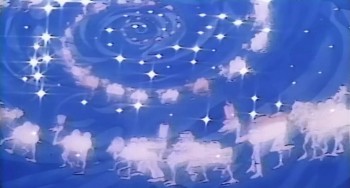 Dick Williams gave me a scene of a mirage the Camel with the Wrinkled Knees would have. 97 dancing camels spiraling into the distance would be superimposed over the Camel’s head. I worked for about six weeks on this one scene, and until I had to be taken off it. The scene near completion went to the newly hired John Kimball who was going to do a number of other similar scenes, and he’d build them all into the film. I moved to head of Assistants and Inbetweeners and definitely had a lot of work to do.
Dick Williams gave me a scene of a mirage the Camel with the Wrinkled Knees would have. 97 dancing camels spiraling into the distance would be superimposed over the Camel’s head. I worked for about six weeks on this one scene, and until I had to be taken off it. The scene near completion went to the newly hired John Kimball who was going to do a number of other similar scenes, and he’d build them all into the film. I moved to head of Assistants and Inbetweeners and definitely had a lot of work to do.
Hiring lots of people in New York and training many of the new faces was foremost. We ended up with seven rooms with about 15 Assistants and Inbetweeners in each room. Finding new people wasn’t always easy, and they didn’t all work out.
In 1976, the Ottawa Animation Festival had its inauguration year. (That was when Caroline Leaf took over the animation world, becoming a star with her film, The Street.) It was here that I went to look for talent, and I found it in several people. John Gaug came down from Atkinson Film Arts in Ottawa. He was a gifted talent and a very tight style. Sheldon Cohen was closer to my heart. His sensitive drawings and warm approach to the artwork made him a definite person to hire. After getting back to New York I let the powers-to-be know that I was hiring the two and made the calls. Both moved dpwn to the City.
 Both continued on after Raggedy Ann ended.
Both continued on after Raggedy Ann ended.
John Gaug moved on to the Williams studio in London where he became an animator, moved back to Ottawa to direct Trolls and the Christmas Express (where I animated freelance for him). Then he moved back to New York working in the commercial studios (I got to hire him again at R. O. Blechman’s studio) until he died in 1984.
.
 Sheldon Cohen moved back to Montreal where he became a unique artist for the National Film Board. He directed and animated a number of strong films. His most famous, The Sweater, showed an artist in full bloom seemingly right out of the box. He continues doing a number of children’s books and recently has written a oersonal memoir called This Sweater Is For You! published by ECW Press in Toronto. The book will soon be on the market, I’ll get a copy and will definitely review it. I’d also like to interview Sheldon about his 40 year career of making art.
Sheldon Cohen moved back to Montreal where he became a unique artist for the National Film Board. He directed and animated a number of strong films. His most famous, The Sweater, showed an artist in full bloom seemingly right out of the box. He continues doing a number of children’s books and recently has written a oersonal memoir called This Sweater Is For You! published by ECW Press in Toronto. The book will soon be on the market, I’ll get a copy and will definitely review it. I’d also like to interview Sheldon about his 40 year career of making art.

In the meantime, you can see a number of Sheldon’s films on the NFB site. I’ve linked those films below.
The Sweater is an adaptation of a Mordecai Richler short story.
I Want a Dog is based on the book by Dayal Kaur Khalsa.
Snow Cat starts out with the feel of the book Goodnight Moon
but soon turns to a very graphic and textured look.
It’s a 23 minute film with wonderful narration by Maureen Stapleton.
Pies, a film about blind prejudice, is based
on a short story by Canadian author Wilma Riley.
_______________________________________________________
Ghibli’s The Secret World of Arrietty opened yesterday to generally positive reviews.
- Manohla Dargis in the NYTimes praised the Ghibli approach to female characters, who often are the leads, but was bothered by some of the elements lost in adapting the original novel, however
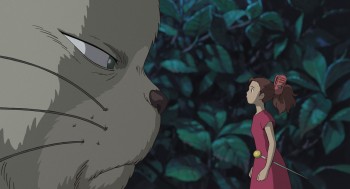 “. . . it’s initially a letdown that Arrietty and Shawn aren’t just friends, as in the book, but also something like impossible romantic foils. Yet this disappointment proves mostly premature because Studio Ghibli and Arrietty have a way of taking you where you may not expect, whether you’re scrambling through rooms as large as canyons or clambering into the safety of an outstretched hand, a simple gesture that says it all.”
“. . . it’s initially a letdown that Arrietty and Shawn aren’t just friends, as in the book, but also something like impossible romantic foils. Yet this disappointment proves mostly premature because Studio Ghibli and Arrietty have a way of taking you where you may not expect, whether you’re scrambling through rooms as large as canyons or clambering into the safety of an outstretched hand, a simple gesture that says it all.” - Lou Leminick in his 3 star review in the NYPost writes:
- Studio Ghibli is at the forefront of keeping traditional hand-drawn animation alive — and it works well even for a story that’s less fantastical than Miyazaki’s signature works.
- Many animated and live-action films have dealt with miniature humans, but few have depicted a sheer sense of scale as effectively as this one.
“The Secret World of Arrietty’’ is a feast for the eyes that will engage the entire family.
- Phillip French in The Observer writes a very positive review:
- At the heart of the film, is the tender, trusting friendship between Shawn, the boy of the house, and Arrietty. Theirs is a beautiful, perfect love, but ultimately doomed like so many relationships in myths and fairytales. This moving, amusing and resonant tale also touches on environmental and ecological concerns, on xenophobia and the fear of the threatening other. And it has taken on new meanings about the respect and preservation of disappearing species and the need to treasure and recycle valuable resources.
.
- Finally, the good news, last night, I won the NAACP IMAGE Award for Outstanding Children’s Program. I’m proud of this one, thankyou very much.
Outstanding Children’s Program
“A.N.T. Farm”
“Dora the Explorer”
“Go, Diego! Go! ”
WINNER: “I Can Be President: A Kid’s-Eye View”
“My Family Tree”
.
Commentary &Independent Animation 19 Dec 2011 06:07 am
The Mouse and His Child Go On
- As I wrote yesterday, the author, Russell Hoban died on Dec. 13th at the age of 86. He was a favorite author of mine. I was lucky to have met him after we completed an animated version of his book, The Marzipan Pig. Prior to that, a feature had been done of his children’s novel, The Mouse and His Child. Here’s a couple of pieces I did about that feature in the past few years.
Sanrio, a Japanese company that made all their money on Hello Kitty products, produced two animated features in the US. Metamorphosis and The Mouse and His Child. Both films failed at the box office. However, The Mouse and His Child, directed by Fred Wolf and Chuck Swenson, has some small glimmers of fine animation throughout the film.
I don’t really know who did any of the animation. Corny Cole, certainly, did the big closing animated zoom of the film. I sought out the work of one animator I liked, and it turned out to be Vincent Davis. It was the first work I saw by him, and I’m still charmed by it.
Here’s a small walk at the beginning of the film. Lots of shape shifting in the assisting, but there’s something nice about it, too. I don’t know who animated it.
 1
1 2
2
______(Click any image to enlarge.)
The Mouse and His Child has some real charm. However, it created a small problem for me.
When I’d begun work on The Marzipan Pig, I had to guarantee the brilliant writer, Russell Hoban, who authored both books – The Marzipan Pig and The Mouse and His Child – that no spoken dialogue would be created by me or Maxine Fisher, who was writing the script. Hoban was annoyed by the script for The Mouse and His Child. He felt they had butchered his story.
In fact, the film ends 3/4 of the way into the story. Elements of the last quarter of the book are rushed through the film in one last scene before the end titles. (I have to admit it’s a bit confusing.) This is a scene Corny animated. It’s all one scene; no cuts; an animated BG.


The Jack In The Box looks very different from the guy in Raggedy Ann.
You can watch this film on YouTube.
Commentary 13 Aug 2011 06:48 am
Rambling Bits
- This past week things kept moving. It started with the news that Standard and (very) Poors had lowered the credit rating of the US, and the stock market rolled up/down/up/down ending UP. It’s frightened quite a few people waiting for the “double dip Recession”. Did John Boehner & Eric Cantor think they would have any other result than this with the past month’s game playing in Congress? Or maybe that was what they wanted, so they could blame the President for it. A made-up crisis has put the US on the brink of a real crisis, and, by nature, the Global Economy as well.
 Then came the more personal news that Corny Cole had died. That was something of a shocker and a very sad one at that. Corny seemed to inspire many in animation today. As one of the heads of CalArts animation program, he’s affected many of the students lives as he inspired many of them on or into the business.
Then came the more personal news that Corny Cole had died. That was something of a shocker and a very sad one at that. Corny seemed to inspire many in animation today. As one of the heads of CalArts animation program, he’s affected many of the students lives as he inspired many of them on or into the business.
There are quite a few blog notes out there. My three favorites are
- – the odd interview posted on Mike Barrier‘s website, MichaelBarrier.com. Corny talks about his days working in Chuck Jones’ unit at Warner Bros., his ________Corny in 1976 on RAGGEDY ANN
days at UPA on Gay Purr-ee and his work
for Richard Williams on The Cobbler & the Thief. There’s a slight paranoia there, and Corny seems to think that others are out to beat him. I’m not sure, from what he says, that that was really an accurate reading. But what do I know?
- On The Animation Guild Blog Dave Brain offers his memories of Corny.
- on Cartoon Brew, Amid Amidi collects a lot of blog posts and points to many of them.
I remember Luis Bunuel‘s introduction to his great autobiography. He was aware that his death would come within another year or two, and he said that he didn’t mind dying if only he could come back once a year to read some of the newspapers because he was addicted to the news and would want to know what happened in the soap opera of life. This hit very close to home. I love the politics of the world (not so much lately now that it’s all good vs evil/black vs white) and would want to continue knowing what’s going on. When I see the culmination of one political event mesh with a friend’s passing, I always wonder about this Bunuel thought. I know, I’m nuts.
 - Speaking of Michael Barrier and his site. Every time he publishes a new interview a lot of attention is garnered. What seems to be forgotten is that Mike has recorded MANY interviews and he has many in the archive of his site. Right up there at the top, on his banner, it says interviews.
- Speaking of Michael Barrier and his site. Every time he publishes a new interview a lot of attention is garnered. What seems to be forgotten is that Mike has recorded MANY interviews and he has many in the archive of his site. Right up there at the top, on his banner, it says interviews.
There you can find quite a few that were originally published in Funnyworld Magazine: Hugh Harman, James Bodrero, Frank Tashlin, John McGrew, Art Babbitt, Dave Hand and many other key personnel from the Golden Age of animation.
They’re all there – for free. You just have to read them.
It’s an amazing resource; take advantage. (I must have read the Dave Hand and John McGrew interviews at least four times, each. I’ve memorized the Hubley interview.)
 - Another very interesting site came to my attention early this week. Network Awesome features a lot of archival videos. Jason Forrest founded the site in January 2011. With it he says he’d like to: “spotlight the best from the past to create something new for the future. In a sense it’s TV about TV but our wider intent is to show something about culture as a whole. This can manifest itself in a kids cartoon from 1973, an interview from 1948 or a movie from 1993.”
- Another very interesting site came to my attention early this week. Network Awesome features a lot of archival videos. Jason Forrest founded the site in January 2011. With it he says he’d like to: “spotlight the best from the past to create something new for the future. In a sense it’s TV about TV but our wider intent is to show something about culture as a whole. This can manifest itself in a kids cartoon from 1973, an interview from 1948 or a movie from 1993.”
You can find anything from an early Astro Boy adventure to The Grave of the Fireflies. This past week they’ve had something of a festival for very early Japanese animation, hosted by Cory Gross. All of these films are extraordinary and certainly worth viewing. Many of them seem to use an early version of the multiplane camera in shooting. The animation style starts looking like a Fleischer clone, and eventually goes more toward Disney.
Here’s what they programmed this past week:
- 1. Fox and Racoon-Dog Playing Pranks on Each Other (1933)
2. Kenzo Masaoka’s Spider and Tulip (1943)
3. Momotaro’s Divine Sea Warriors (1945)
4. Koneko No Rakugaki (1957)
They also have an on-line magazine which gives detailed information about each film on the site. Here’s a sample of the page for Spider and Tulip. It tells who Kenzo Masaoka was and what his role in the history of Japanese animation was. The film was animated during the height of WWII, so the implications are obvious. Yet compare it to what Disney was doing at the time; it’s an amazing piece.
- I also reviewed Timothy Susanin’s book, Mickey Before Mickey: Disney’s Early Years 1919-1928. I hardly believed that my review would lead to a conversation via email with Mr. Susanin. I have to say that it was a treat. The book made a strong impression on me.
Lately, I’d been reading a lot of interviews with people around the Disney studio in the 20′s, 30′s and early 40′s. Didier Ghez’ spectacular series of books: Walt’s People Vols 1-11. I only have three, but it gives me plenty to look forward to. Working with Walt and Working With Disney, both by Don Peri. These two are juicy books and have some excellent interviews within. Consequently, reading Mr. Susanin’s book came at exactly the right time for me. While reading that I pulled the two Barrier books off the shelf: The Animated Man and Hollywood Cartoons as well as the Kaufman and Merritt book, Walt in Wonderland. I’d already read each of these three several times, but it was fun rereading them while seeing how much Mr. Susanin added to the picture (and it often was a lot.) For some reason, this offends a number of reviewers, such as Charles Solomon in the LA Times. I don’t quite know why. Perhaps, he just wants to get the Cliff Notes in history books. I want all the meat and bones and gristle. Perhaps, Mr. Susanin wrote his book specifically for me. It certainly got me charged.
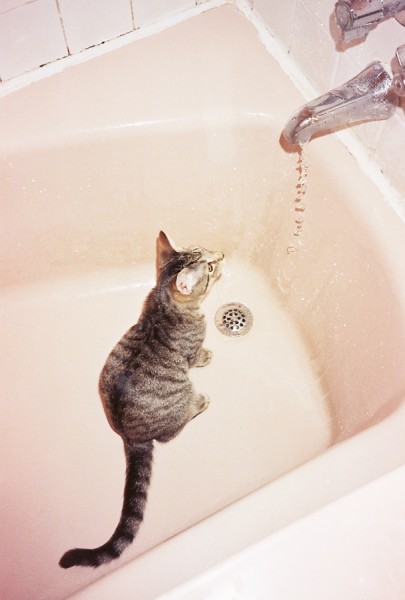
Alex, one of our cats, has always had a fascination with water.

He’s now fully grown and sits in the bathtub under the dripping water.
He comes out with a soaking wet head and
likes to hit you in the face with it.
Animation &Animation Artifacts 12 Aug 2011 07:10 am
Corny’s Cartoon
Since Corny Cole died on Monday, there have been quite a few comments on various blogs. To me, the most valuable of those I’d seen was the one posted late yesterday by Michael Barrier. It is an interview done with Milton Gray and Corny in 1991. They talk primarily about the days Corny worked under Chuck Jones at Warner Bros. and the days working at UPA on Gay Purr-ee, under the recommendation of Jones. Amid Amidi also posted a fine memorial to Corny on Cartoon Brew this morning.
I have a few scenes done by Corny Cole from Raggedy Ann and Andy, and I hope to post some of his art. However, animator, Matthew Clinton sent me the following scene and offered it for posting. Matt had a close relationship with Corny and I thought the scene somehow special. Somehow, to me, it captures the essence of Corny’s animation, so I thought it appropriate to post this week. Here’s the comment Matt sent along with the artwork:
- Corny Cole gave this scene to me as a gift when I graduated. I’m guessing that it was something he worked on in his “Animation as Art” class while the students were busy drawing one day. Maybe it was for a demonstration. I included scans of all the drawings.
Corny talks, in the Barrier interview, of animating just by flipping without a bottom light. It’s easy to imagine him sitting in the front of the classroom flipping away with this artwork on his lap. It’s obviously stream of conscience. There are elements of some of Corny’s last big jobs in there: the taffy pit from Raggedy Ann and the clockwork mouse (a Disney/Mickey bastardization) from The Mouse & His Child, both features designed by Corny.

Cover sheet
. . . . . . . . . . . . . . . . . . . . . . . . . . . . .
 49
49
The clockwork mouse about to be swallowed by the Taffy Pit.
.
This is a QT of Corny’s piece. Since most drawings were exposed on 6′s,
I put one frame dissolves between each to soften the extremes.
Animation Artifacts &Richard Williams 22 Feb 2011 08:18 am
Raggedy Drafts – 7/ seq. 12
- Here we go with the final installment of the Raggedy Ann & Andy: A Musical Adventure drafts. This, of course, was the feature Richard Williams directed (3/4 of the way) in 1977. You’ll note that as we’ve gone on, the drafts have gotten sloppier and sloppier. This last batch (separated from the last installment by 2 sequences of live-action film) included a couple of faux sheets. They were started and redone. I only include the redone sheets.
The animators working on this ending sequence include: Hal Ambro, Dick Williams, Tissa David, Jim Logan, Tom Roth, Spencer Peel, Irv Spence,Art Vitelo, Art Babbitt, Dan Haskett, Cosmo Anzilotti and John Gaug.
The final three sheets are a sequence breakdown – a reduction of the drafts, in case you’ve lost your place and want to find out what sequence to look for.

A Corny Cole rough (above) done with BIC pen and
a Corny Cole clean up (below) done in pencil.
Sequence 12
 1
1
Corny Cole storyboard drawings.
Sequence Breakdown
Animation &Animation Artifacts &Richard Williams &Tissa David 16 Feb 2011 08:15 am
Raggedy Drafts – 6 / seq. 7, 8 & 9
- Continuing on with the Raggedy Ann & Andy: A Musical Adventure drafts, we move onto seqeunces 7, 8 and 9. This involves the Loony King, the Loony Knight and Babette at sea.
Animators for these sequences include: George Bakes, Gerry Chiniquy, Doug Crane, Dick Williams, Chrystal (Russell) Kablunde, Hal Ambro, Charlie Downs, Art Vitello, Jack Schnerk, Corny Cole, Tom Roth, Irv Spence, Bob Bemiller, and Warren Batchelder.
A lot of talent in one place; too bad the film doesn’t hint at it.
To dress up the post I’ve added five of Tissa’s key drawings from an early scene.

Sequence 7
Sequence 8
 8-5
8-5
For some reason this bad drawing of the “Greedy” was attached
to the drafts. So I just iuncluded it here, as well.
Sequence 9
Animation Artifacts &Richard Williams 17 Jan 2011 09:20 am
Raggedy Drafts – 2 / seq. 3
- Continuing with the drafts I have from Raggedy Ann & Andy, I give you sequence 3.1, 3.2 & 3.3.
The animators employed are: Hal Ambro, Sencer Peel, Dick Williams, Charlie Downs, Tissa David, John Bruno, Jack Schnerk, Chrystal (Russell) Klabunde, Gerry Chiniquy, Doug Crane, and Willis Pyle.
Dick Williams did most of the cleanup of this sequence himself. He was particularly interested in the character of “Babette” which Hal Ambro animated. Dick reworked every one of those scenes while doing CU & Inbts. I’ve posted a model sheet of Babette from one of the scenes in this sequence.
For those of you who’d rather see artwork than charts, I give you another of Corny Cole’s oversized stunning bits of preliminary artwork for Tissa David‘s sequence, the deep dark woods.
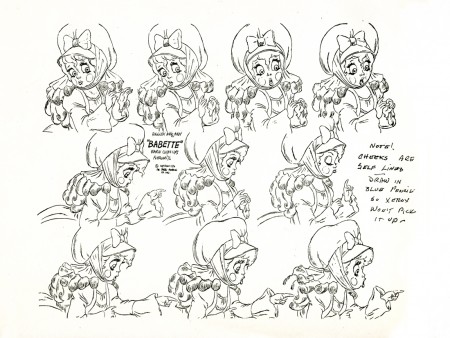
“Babette”


